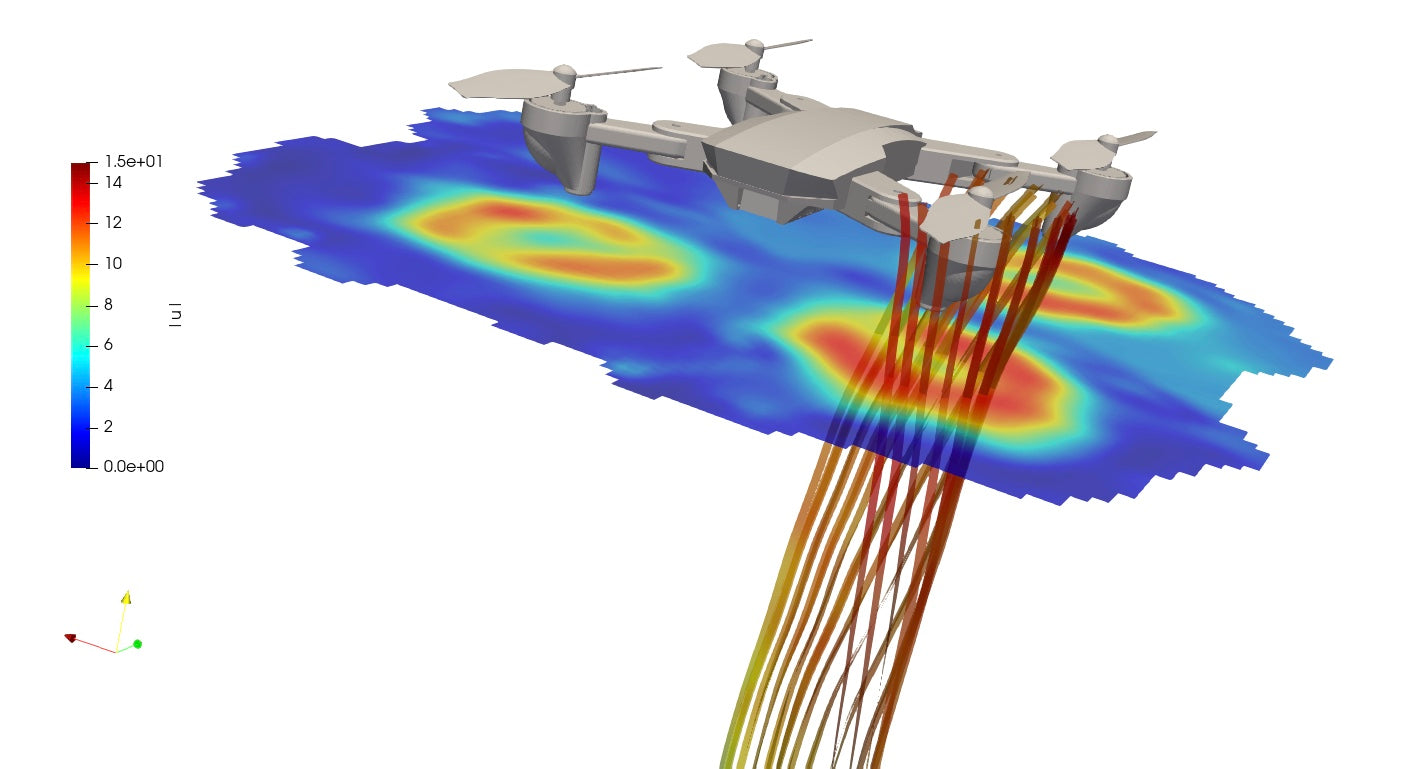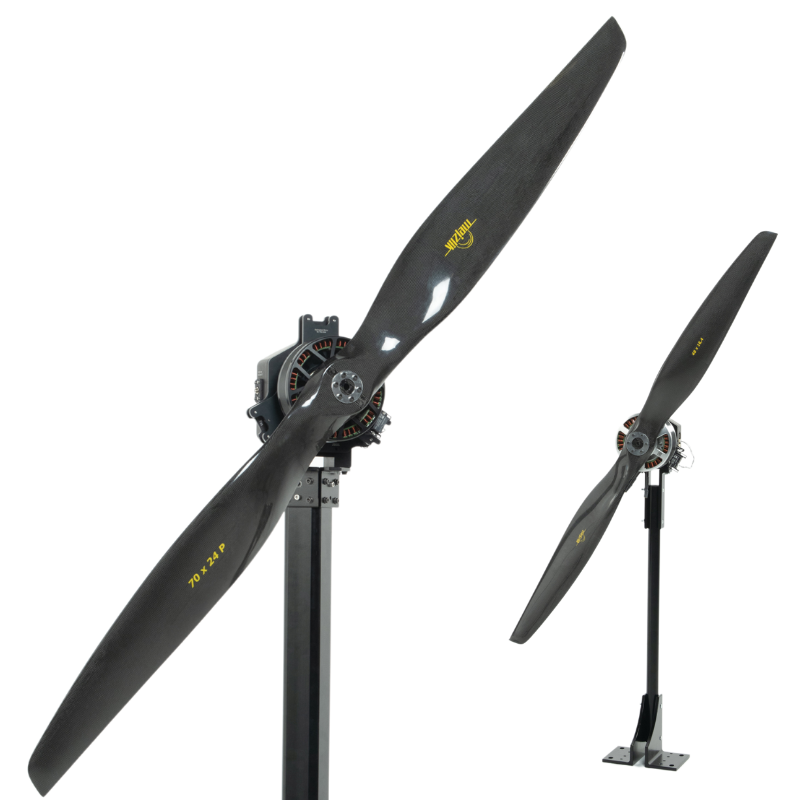By Lauren Nagel
Wind tunnels are a valuable piece of equipment for characterizing object aerodynamics. There are several types of wind tunnels that work in different ways.
In this article we will cover:
- How wind tunnels work
- Types of wind tunnels (speed, open vs. closed return, open air, and CFD)
- How wind tunnels are used to design aircraft
- Comparison of types of wind tunnels
1. How Wind Tunnels Work
Wind tunnels are an excellent tool for producing wind flows in a controlled setting to replicate flying conditions.
By using one or more fans to force air over an object, one can visualize the interaction between the object and the surrounding airflow in order to predict its aerodynamics.

Figure 1: Installing a model aircraft in the test area of a wind tunnel
In traditional wind tunnel testing, wind is generated by a fan and passed through a test area where the object of interest is installed. The tunnels themselves vary in size and shape.
Most wind tunnels have either an open or closed style return. For some supersonic testing, blowdown style tunnels may also be used, which rely on a pressure difference between a high pressure basin upstream of the test area and a low pressure reservoir downstream.
Wind tunnel tests may use a combination of air pressure sensors, force balances, and physical indicators like smoke, oil and paint to characterize how an object interacts with a wind flow.
Advanced methods include pressure sensitive paint, which changes colour with variations in pressure, and particle image velocimetry, which uses a laser sheet to track the velocity of particles passing through a plane in the test area.

Figure 2: Testing a full-size U.S. Navy aircraft in a wind tunnel
2. Types of Wind Tunnels
There are a number of ways to identify the different types of wind tunnels, such as speed, configuration, style, and output.
Wind Tunnel Speed
Traditional wind tunnels are classified by the speed of the air passing through the test section relative to the speed of sound (Mach 1). They are divided into four categories: subsonic (Mach <0.8), transonic (Mach 0.8 – 1.2), supersonic (Mach 1.2 – 5.0), and hypersonic (Mach >5.0).
The category limits are based on the magnitude of compressibility effects that must be considered for flights at that speed.
As objects move faster and faster, they compress the surrounding gases, thus changing the fluid density and altering the amount of force on the aircraft.
This effect does not occur at subsonic speeds, but has unique effects at transonic, supersonic and hypersonic speeds, hence the categorization.
Open vs. Closed Return
Wind tunnels come in many configurations, but open and closed return tunnels are most common, differing in their shape and how the air is circulated.
Open wind tunnels have open ends on both sides of the test section and gather air from the environment where the tunnel is located.
Once the air passes through the test section and out one end of the tunnel, it is recirculated through the room to the tunnel entrance where it can re-enter the tunnel (figure 3).
An open wind tunnel with an open test section is also known as an “Eiffel tunnel”, named after Gustave Eiffel who used his Parisien wind tunnel to study the properties of lift on an airfoil.
An open tunnel with a closed test section is also known as an “NPL tunnel”, named after the National Physical Laboratory where they were first used.

Figure 3: Open return wind tunnel (grc.nasa.gov)
Closed wind tunnels use a self-contained circuit that recirculates air within the tunnel through the test section (figure 4).
The tunnel is not open to the test environment surrounding the apparatus, so the same air is circulated over and over again. Turning vanes help to create smoother changes in direction for the airflow throughout the tunnel.
Closed wind tunnels are also known as “Prandtl tunnels” after Ludwig Prandtl who developed the first theories on supersonic shockwaves. They also go by “Gottingen tunnels”, named after the German research laboratory where they were first used.

Figure 4: Closed return wind tunnel (grc.nasa.gov)
The benefits of traditional wind tunnels like these include their ability to produce high speed flows and their ability to restrict the test area.
That said, restricting the test area also makes it more challenging to test an aircraft in motion since space is limited. Models are often used in traditional wind tunnel testing since tunnels able to test full size aircraft are extremely costly to build.
The world’s largest wind tunnel, measuring 80' x 120’ and based at the NASA Ames Research Center in California, was constructed through the modification of a smaller 40' x 80’ wind tunnel. The project budget in 1979 was $85 million USD, equivalent to about $350 million USD today.
Open Air Wind “Tunnels” / Windshapers
Open air wind tunnels, or Windshapers, are a promising alternative to traditional closed wind tunnels.
This option is especially relevant for free flight testing of aircraft and drones as it allows for tests without the boundaries of a physical tunnel. Such open air facilities can accommodate the same size aircraft for a fraction of the cost of a traditional wind tunnel.
Open air wind tunnels differ from traditional wind tunnels in that the test area is open to the environment and not enclosed within a tunnel (figure 7).
A wall of fans produces a 3D wind flow based on a three variable function (x, y, z). The function communicates information to the individual fans, which can produce all kinds of wind profiles, such as waves, turbulence, wind bursts, etc.
The wind flow is directed through an open test area where the aircraft is located. This allows the aircraft to fly freely without needing to be mounted in place.
Further reading: Why You Should Test Your UAV's Motors and Propellers

Figure 7: Drone testing with an open air wind tunnel (Windshaper)
Air flow visualization with an open air system is made possible through motion tracking and flow probe technologies used simultaneously.
Flow visualization software combines data from the two sources, then processes, interpolates and visualizes the data (figure 8).
The data collected can be visualized in real time or analyzed later using standard CFD visualization tools.

Figure 8: Drone airflow visualization with ProCap technology by Streamwise
The diversity of wind profiles produced with one or multiple walls of fans is great for simulating a flight through difficult weather or around buildings and terrain.
This video by the government of Canada provides a great demonstration of the challenges of urban flying with a drone, for example, and the kind of skills inner-city pilots must develop.
Because of the unenclosed nature of the test area, open air wind tunnels also allow you to test take-off and landing configurations.
Windshapers have a tilting function that allows them to rotate up to 90 degrees. This allows the user to practice the most critical phases of flight while simulating ground effect, thermal updrafts, crosswinds, etc.
In addition, climatic effects can be added to the test area, such as rain, snow or fog (figure 9).

Figure 9: Drone testing in rainy conditions
Open air wind tunnels are relatively inexpensive compared to traditional wind tunnels with the same cross-sectional test area. They therefore provide more feasible free flight testing.
So far no open air wind tunnels have been constructed that reach transonic speeds, which is one downside of the model.
Computer Simulation / CFD
Computer-based wind tunnel simulation, or computational fluid dynamics (CFD), can be used independently or hand in hand with physical testing to understand an object’s aerodynamics.
In budget-limited projects, simulation may be the only method used to evaluate an object, whereas in larger projects it may inform and compliment physical wind tunnel testing.

Figure 5: Visualization of airflow over a wing flap by AirShaper
Computer-based programs can start with as little input as a 3D model or 3D scan of an aircraft. The model is uploaded into the testing software and subjected to different simulated wind conditions.
The user can control the wind speed, angle of attack, aircraft movement, and the properties of the fluid.
The results of the simulation provide key information such as wind shape, surface pressure, and wind flow separation along portions of the aircraft (figure 6).
For newcomers to CFD, NASA offers several free wind tunnel software designed to teach the basics of aerodynamics and propulsion. For more advanced commercial uses, companies like AirShaper and SimScale offer solutions that allow clients to produce detailed models and comprehensive wind profiles.

Figure 6: Aircraft landing gear flow visualization with SimScale CFD technology
Overall, CFD is a cost effective way to collect theoretical aerodynamic data, especially as the technology becomes more advanced.
At the end of the day, however, the data is just that, theoretical.
We ran an experiment to see how CFD data compared to real world conditions for propeller testing, and the results were quite interesting.
3. How Wind Tunnels are Used to Design Aircraft
Wind tunnels can help aircraft builders improve their design by identifying areas where aerodynamics can be improved.
This allows designers to improve their lift: drag ratio, which can translate into improved flight times and improved resistance to turbulence.
More advanced wind tunnels can also simulate turbulence and sideways wind flows to study performance in diverse flight situations.
The size of the wind tunnel required depends on the size of the aircraft and the type of testing performed. Some wind tunnels are large enough to test full size aircraft while others employ models to make assumptions about the full size versions.
A larger tunnel will be required for free flight testing compared to testing a mounted aircraft model, for example.
4. Comparison of Types of Wind Tunnels
Here is a comparison of three types of wind tunnels:

Conclusion
For more information on traditional wind tunnel testing and CFD, check out the companies and links mentioned in the text.
For more information on open air wind tunnel testing (Windshapers), check out our wind tunnel testing landing page.
Further reading: Wind Tunnel Testing at the University of Ottawa


 Back to Blog
Back to Blog


Leave a comment